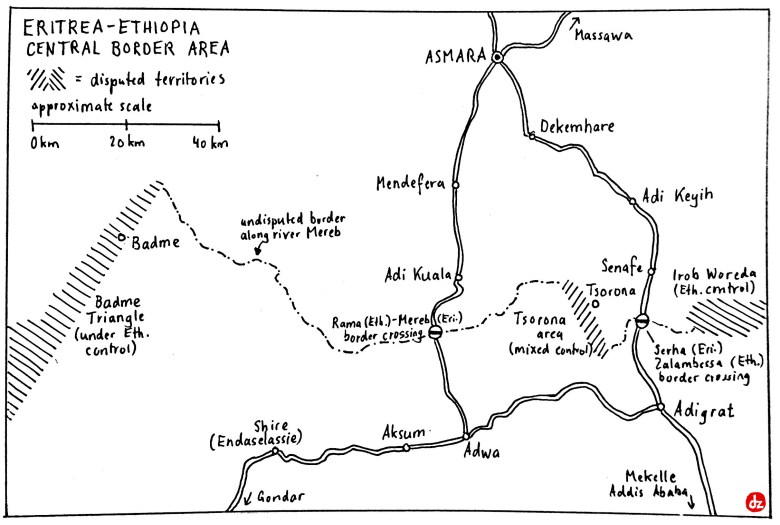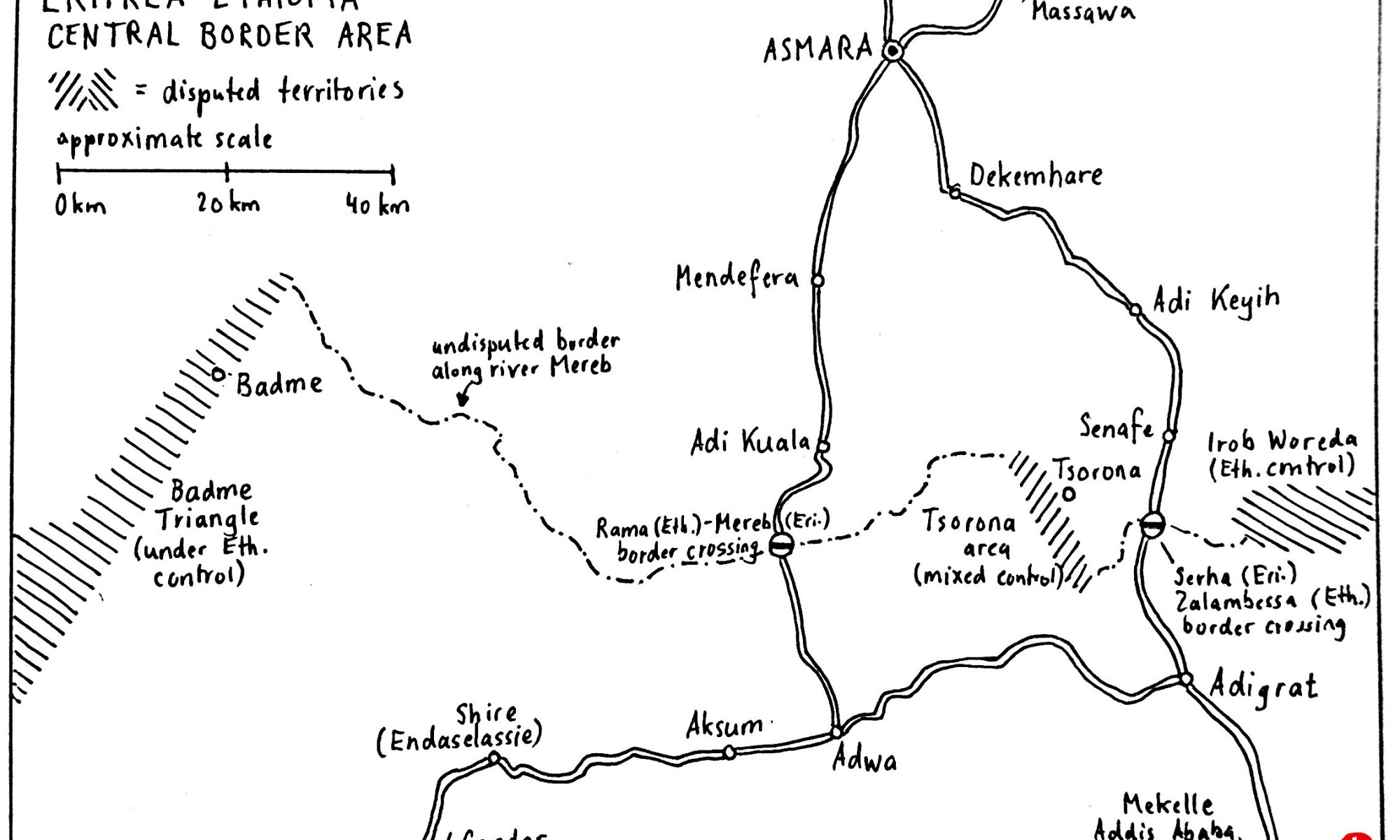Last update: 22 April 2019 – will be updated in case of new information.
Background
From 1998 to 2000, Eritrea and Ethiopia fought a border war. It ended in a ceasefire, both parties agreed to accept a UN ruling which should determine the border. In 2002, the UN ruling was passed. Eritrea accepted it, Ethiopia didn’t. Instead, it kept disputed territories assigned to Eritrea under its control and demanded renegotiations. For almost two decades, the border remained tense, a frontline. All crossings were closed.
2018 finally brought peace: After a change in power, Ethiopia declared unconditional acceptance of the 2002 UN ruling. Bilateral meetings and the exchange of ambassadors paved the way to a formal peace agreement, and on 11 September 2018, the border crossings opened again. Eritreans and Ethiopians euphorically started to rediscover their neighbours, trade links were quickly re-established.
The opening of the border crossings
Starting from September 2018, three border crossings were open:
- Bure (Ethiopia) / Debay Sima (Eritrea) crossing on the road from Ethiopia’s Afar state to the Eritrean port of Assab (officially opened on 11 September 2018);
- Zalambessa (Ethiopia) / Serha (Eritrea), on the road from Adigrat to Senafe (officially opened on 11 September 2018);
- Rama (Ethiopia) / Ksadika (Eritrea), on the bridge across river Mereb/Gash, on the road from Adwa to Adi Kuala (opened approx. 15 September 2018).
Additionally, on 7 Januar 2019 the Humera (Ethiopia) / Omhajer (Eritrea) border crossing on Tekeze/Setit river near the border tripoint with Sudan officially opened. President Isaias and PM Abiy gathered again, celebrations ensued. It has been their last meeting since (as of April 2019).

The main issue of the border conflict, however, remains unresolved: Ethiopia has not pulled out of the disputed areas (see map above), whose future seems to be still unclear. Apparently, troops have moved away from the border, but no territory has been handed over so far. Most probably due to domestic political reasons, by April 2019, Ethiopia’s Prime Minister Abiy Ahmed has not been able to fulfil this announcement to unconditionally accept and execute the 2002 UN ruling.
The closure of the border crossings
On 26 December 2018, Eritrea unilaterally introduced substantial restrictions to the two of the border crossings opened in September 2018, Zalembessa/Serha and Rama/Ksadika. Ethiopian cars were not allowed into Eritrean territory anymore, restrictions on the import of goods were introduced, and Ethiopians reportedly were demanded a „support letter of the federal government“ by the Eritreans. There has never been an official announcement though, so confusion ruled.
It was not a full border closure: For a couple of days in December 2018 and January 2019, the two border crossings remained open; travellers crossed in both directions. Mostly (maybe exclusively), these were people returning to their homelands. This stopped eventually.
Since Mid-January 2019, the Rama and Zalambessa border crossings effectively have remained closed for all traffic.
On 16 January 2019, Eritrea and Ethiopia announced the establishment of commercial checkpoints at all four open border crossings. In February 2019, the two governments reiterated the plans for a formal agreement regulating bilateral trade and transport.
On 7 January 2019, the Humera/Omhajer border crossing opened, located at the Western extreme of the common border, close to Sudan. It replaced the previously closed crossings; in early 2019 most individual and goods traffic flowed through it. On 18 April 2019, media (referring to BBC’s Tigrinya service) reported the closure of the Humera/Omhajer border crossing.
On 22 April 2019, diaspora media reported that the Bure/Debay Sima border crossing has been closed as well. Again, there was no official announcement by the Eritrean authorities. The Ethiopian authorities reportedly had not been aware of the closure. Currently, all land borders between Eritrea and Ethiopia are thuse closed. However, preparations for a better organized opening of them are still underway.
Crossing the border as a local
Ethiopia and Eritrea literally went overnight from a firmly closed military frontline to a Schengen Area situation on 11 September 2018. After that, Eritreans and Ethiopians were able to cross the border at the above-mentioned crossings. Initially, there were no controls at all, people and goods went unchecked on both sides. This brought down prices in Eritrea massively. People crossing carried their IDs, but generally no passports or exit visa.
After a couple of weeks (supposedly at some point in October 2018) the Eritrean side set up military checkpoints, where ID papers were checked. According to a tweet which has meanwhile been deleted, personal data were registered at the Serha/Zalambessa crossing. Soldiers copied them into a big book, but there was no digital registration. In late 2018, some Eritrean border checkpoints reportedly started to ask for exit visas.
Since the closure of the three initially opened border crossings in Mid-January 2019 and of the Humera/Omhajer border crossing in April 2019, travelling between Eritrea and Ethiopia is possible only by plane. Eriterans and Ethiopians need passports and visa for that.
Crossing the border as a foreigner
Like many others, I had hoped to be able to cross this new land border. However, as of April 2019 foreigners have not been formally allowed to cross the land border. The border crossings were largely unregulated, no proper immigration and custom facilities were in place. Regarding the potential crossing of foreigners, so far (as of April 2019) the following information is known:
- As of 22 April 2019, all land border crossings are closed, locals and foreigners alike cannot cross.
- There are no immigration or customs checks at the border. On the Eritrean side, the military is in charge of checks. They are not able to process foreign documents or visa, not even to stamp passports.
- On the Ethiopian side, there are no systematic checks. Presumably, foreigners would be able to pass unhindered. In any case, however, they would not be able to get exit stamps in their passports – which upon return to Ethiopia could be interpreted as an illegal exit.
- In Eritrea, foreigners need a travel permit for all trips outside of a 25 km perimeter around the capital, Asmara. These permits are issued exclusively in Asmara. A couple of years ago, tourists have been able to enter Eritrea by land from Sudan and then to travel on without a permit to Asmara. There have been no recent reports about the issue.
- Travel permits are usually not issued to tourists for the area around Assab, and for the Southeastern border area (Gash-Barka). Therefore, trying to cross at Humera/Omhajer or Bure would be unwise.
- The Eritrean embassy in Addis Ababa and the Ethiopian embassy in Asmara are operative. There are still no reports about foreigners who managed to get an Eritrean visa in Addis Ababa.
There are very few accounts on foreigners who have tried to cross by land after September 2018:
- In the first weeks of the border opening, some foreigners crossed out of curiosity to have a coffee on the other side (i.e. in Senafe or Adigrat). They were not checked and returned briefly afterwards. No formal procedures were in place at that time.
- In late 2018, there was user of TripAdvisor travel forum claimed there had been a group of tourists crossing the land border with their Ethiopian guides. There was no more specified information about it, however.
- A group of foreigners who tried to cross in early 2019 – having visas of both countries – succeeded in leaving Ethiopia (there being no checks), but refused entry by Eritrean officials.
- In early 2019, tourists who tried to cross from Humera (Ethiopia) to Omhajer (Eritrea) were told to travel on to Tesseney (at the Eritrean-Sudanese border) to get the entry stamp there.
- In March 2019, a Swiss journalist reported having crossed the bridge from Humera to Omhajer accidentally. The Eritrean officials told him he was free to travel on to Asmara, even without visa and passport, but he did not dare to do so.
What we don’t know yet:
- It is not known whether the land border crossings are opening again and if there are any plans to put procedures for foreigners in place.
- Theoretically, there is a possibility to legalize the entry into the new country post facto, i.e. by getting the entry stamp in a nearby city or the capital. I did so once in Moldova after entering the country through Transnistria, a de facto state not controlled by the central government. There is no information, however, if such a solution is possible in Ethiopia and Eritrea; it is not likely, though.
- It is unclear whether it is possible to travel from the border to Asmara without a travel permit, or if such a permit can be obtained somehow from abroad.
- It is unclear whether the above-mentioned embassies issue visas to foreigners.

A great story with details for a crossing, I will most likely never use. But interesting to read about locals crossing this border versus foreigners, eg. tourists.
LikeGefällt 1 Person
Me and a friend are looking to cross in about a month or so. Wondering what you recommend in terms of getting into Eritrea? Also, what have you done next?
LikeLike
For getting into Eritrea, you will need to fly from Addis Ababa (or Khartum, or Dubai etc.). That is currently the only way to get in. Things might change in the near future, but if you have to plan in advance, flying is clearly the safe bet. I have not entered Eritrea.
LikeLike